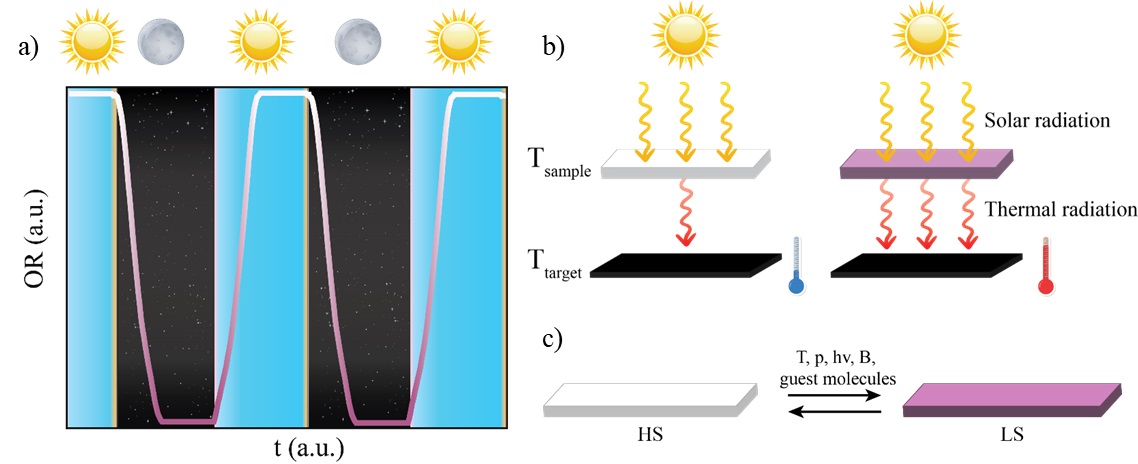Temperature fluctuation control with a switchable spin-crossover material
05.07.2022
 |
|
Behaviour of the spin-crossover material during day-night cycles. Credit: Advanced Science. |
- IMDEA Nanociencia researchers demonstrate the passive thermal regulation using a material based on a spin-crossover switch.
- The heat from the sun can trigger a spin-crossover in a molecule-based material and a concomitant color variation from pink to white.
- The reversible changes in the material’s reflectivity lead to a cooling effect respect to other thermochromic materials, with potential applications in temperature control in buildings.
Madrid, July 4th, 2022. Alleviating the heat-island effect through introducing thermal regulation mechanisms in building elements can improve human thermal comfort and living environment in urban areas. Passive thermal regulation systems incorporated to roofs, windows or walls, and operating without the need for electricity, are an energy-efficient and environmentally sustainable solution.
Phase changing materials minimize the temperature fluctuations through the use of latent heat, but display some limitations. The application of these techniques has resulted in cooling during both day and night. Therefore, the research of new materials that reduce temperature fluctuations in both directions still needs to be developed.
 Researchers led by Dr. José Sánchez-Costa and Dr. Ana Espinosa at IMDEA Nanociencia have demonstrated that molecular materials can be applied for thermal regulation purposes in a novel approach. In their latest work, published in Advanced Science, the group tested molecular-based coordination polymers embedded in plastic matrices against several heating-cooling cycles. They observed a concomitant phase transition and colour change, from pink to white, that resulted in a cooling effect respect to other thermochromic materials. The measured temperatures indicated that the heated material was able to dissipate heat more efficiently via two effects: energy absorption that triggers the phase transition and optical reflection due to colour change towards white -reflecting more energy. Further, the cooled material (pink) produced a dampening of the temperature decrease due to the desorption of heat produced in the phase transition. This translates into lower temperature fluctuation during heating and cooling cycles.
Researchers led by Dr. José Sánchez-Costa and Dr. Ana Espinosa at IMDEA Nanociencia have demonstrated that molecular materials can be applied for thermal regulation purposes in a novel approach. In their latest work, published in Advanced Science, the group tested molecular-based coordination polymers embedded in plastic matrices against several heating-cooling cycles. They observed a concomitant phase transition and colour change, from pink to white, that resulted in a cooling effect respect to other thermochromic materials. The measured temperatures indicated that the heated material was able to dissipate heat more efficiently via two effects: energy absorption that triggers the phase transition and optical reflection due to colour change towards white -reflecting more energy. Further, the cooled material (pink) produced a dampening of the temperature decrease due to the desorption of heat produced in the phase transition. This translates into lower temperature fluctuation during heating and cooling cycles.
The spin-crossover molecule materials were remarkably stable upon cycling; in this study up to 40 cycles were performed, arising similar results. These spin-crossover are versatile materials ready to be designed for specific intended properties, such as transition temperature and thermal hysteresis.
“Climate change is one of the most serious problems that we are going to face in the coming years, everything we can do to reduce its effects is almost a must as scientists” Dr. Sánchez-Costa says; “The results obtained in this work are very exciting and open the way to use these switchable materials in real applications, if we think in integrating these in roof or in windows of buildings, since they combine the action of optical reflectivity with the absorption of heat due to the material's phase change. This type of material had never been explored to regulate the temperature inside buildings”.
"The results obtained in this work are very exciting [...] this type of material had never been explored to regulate the temperature inside buildings".
In this study, the researchers demonstrate that the heat generated by the Sun is sufficient to produce spin transition in a spin-crossover material. This, in turn, leads to a cooling effect respect to other similar materials, due to an increase in light reflection resulting from the colour change and the energy absorption associated with the spin transition. Therefore, spin-crossover molecular materials could be used to reduce temperature fluctuations, and could be potentially implemented in passive temperature control elements in buildings.
This work is a collaboration amongst researchers at IMDEA Nanociencia, Instituto de Cerámica y Vidrio (CSIC), Instituto de Ciencia de Materiales (CSIC) and Institut Laue-Langevin (Grenoble) and has been co-funded by the NANOMAGCOST project and the Severo Ochoa Excellence Award to IMDEA Nanociencia.
Reference:
Resines-Urien, E., García-Tuñón, M. Á. G., García-Hernández, M., Rodríguez-Velamazán, J. A., Espinosa, A., Costa, J. S. Concomitant thermochromic and phase-change effect in a switchable spin crossover material for efficient passive control of day and night temperature fluctuations. Adv. Sci. 2022, 2202253.
Contact:
Dr. José Sánchez Costa
jose.sanchezcosta [at]imdea.org
https://nanociencia.imdea.org/switchable-nanomaterials-group/group-home
Twitter: @josescostalab
Dissemination and Communication Office - IMDEA Nanociencia
divulgacion.nanociencia [at]imdea.org
Twitter: @imdea_nano
Facebook: @imdeananociencia
Instagram: @imdeananociencia
Source: IMDEA Nanociencia




